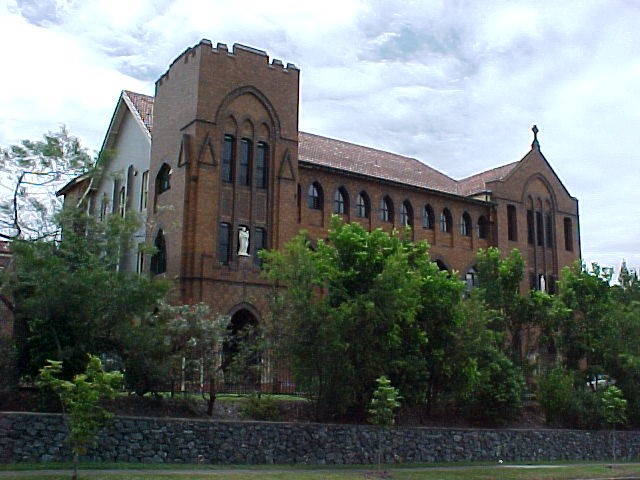Addresses
Type of place
Residence (group), Institutional / group housing
Period
Interwar 1919-1939
Style
Gothic
Addresses
Type of place
Residence (group), Institutional / group housing
Period
Interwar 1919-1939
Style
Gothic
This local landmark was completed in 1929 for the Redemptorist Order of priests and brothers, who provided religious services to the local Catholic community and raised animals on the surrounding land to provide milk to local orphanages and convents. The Redemptorist fathers lived in the monastery until 1985 when the building was sold. Around 1992, it was converted for use as an aged persons hostel and nursing home. The former monastery is an imposing building designed in the Interwar Gothic style by Hennessy, Hennessy, Keesing and Co.
Lot plan
L61_RP96702
Key dates
Local Heritage Place Since —
Date of Citation —
Construction
Roof: Terracotta tile;Walls: Face brick
People/associations
Hennessy, Hennessy, Keesing and Co (Architect)Criterion for listing
(A) Historical; (E) Aesthetic; (G) Social; (H) Historical associationInteractive mapping
Lot plan
L61_RP96702
Key dates
Local Heritage Place Since —
Date of Citation —
Construction
Roof: Terracotta tile;Walls: Face brick
People/associations
Hennessy, Hennessy, Keesing and Co (Architect)Criterion for listing
(A) Historical; (E) Aesthetic; (G) Social; (H) Historical associationInteractive mapping
History
In around 1920 the priests and brothers of the Redemptorist Order acquired the property “Grovely Lodge” as its Brisbane base. However, the original building proved to be unsuitable, and in 1926 architectural firm Hennessy, Hennessy, Keesing & Co drew up plans for a new monastery high on the hill. The three storey red brick L-shaped building was designed to provide living accommodation for the fathers, and planned to be eventually connected by a two-storey cloister with a church on the Samford Road end of the site. The church was never constructed, but the Gothic style monastery went ahead. Archbishop Duhig laid the foundation stone in 1926, and the fathers moved into their new home in March 1929.
Archbishop Duhig had invited the Redemptorist fathers to the Brisbane Archdiocese in 1917. The original house, followed by the monastery became the centre of theological studies and missionary work in the district. The Redemptorist fathers provided religious services, including administering the sacraments to Catholics in the district, and assisted the priests in the Grovely and Mitchelton parishes. On the original 15 acre site the Redemptorist fathers kept pigs and poultry, and ran a large dairy herd, which supplied milk to orphanages and convents. The Redemptorist priests continued to serve and live in the community until 1985 when the monastery was sold to the Archdiocese of Brisbane. Around 1992 the monastery was converted to an aged persons hostel and nursing home, and a retirement village was constructed in the grounds.
The monastery has occupied its elevated site overlooking the surrounding district for almost 70 years. The imposing red brick building, displaying the creative use of brick detailing for which Hennessy and Hennessy architects were renowned, remains a valued local landmark.
Local legend has it that the Oxford Park railway station, located just to the north of the monastery along Church Road, was constructed to facilitate the delivery of building materials. The Enoggera-Samford railway extension had been completed in 1918, and the flanking Mitchelton and Grovely stations opened in that year. Public demand for the opening of another station between Mitchelton and Grovely appears to have forced the Railways Department to consider the placement of another station, allowing easier access by numbers of local commuters who complained about the length of the walk to the nearest station. Oxford Park opened in 1920, six years before construction of the new monastery began, but it remained little more than a siding with shelter shed until rapid post-war growth of the suburb necessitated the appointment of a station mistress and the construction of a platform.
Statement of significance
Relevant assessment criteria
This is a place of local heritage significance and meets one or more of the local heritage criteria under the Heritage planning scheme policy of the Brisbane City Plan 2014. It is significant because:
References
-
Arana Hills and District, p. 125
-
Architectural and Building Journal of Queensland, 4, 45, 10 March 1926, p. 90
-
Brisbane City Council Water Supply and Sewerage Detail Plan 2537, 27 October 1966
-
Kerr, John. Brunswick Street, Bowen Hills and Beyond: The Railways of the Northern Suburbs of Brisbane. Australian Railway Historical Society – Qld Division, Brisbane, 1988, pp. 73-4
-
The Courier Mail, 3 Feb 1920, p. 6
-
Ware, L. (comp) St William’s Parish Grovely: The First 25 Years 1960-1985, Brisbane, 1985
-
Watson, Donald and Judith McKay. A Directory of Queensland Architects to 1940, UQP, Brisbane, 1984, p. 103
Citation prepared by — Brisbane City Council (page revised June 2022)

